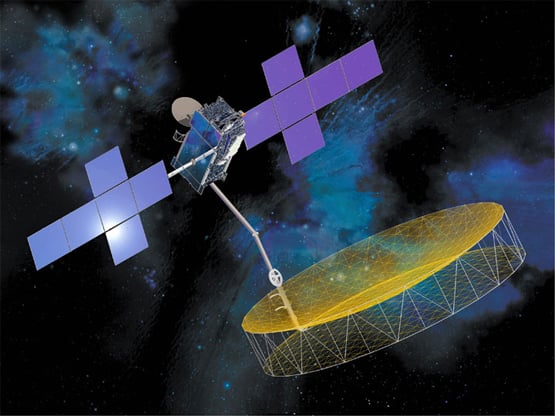Can GSM/Satellite Hybrid Phones Go Mainstream?
While satellite phones were last hot during the original Jurassic Park,
there's apparently still a market out there for folks who find
themselves in some of the world's most remote locales. TerreStar
Corporation and SkyTerra are attempting to do what rivals Iridium and Globalstar
haven't been able to: launch a serious sat phone service without having
to resort to bankruptcy just years after the initial investment.

In two months, TerreStar is expected to shoot a massive commercial satellite into space, some 22,000 miles above Planet Earth. Once there, the device will lay out an "umbrella of gold mesh" that measures 60 feet across and aims directly at the United States. This antenna net will provide sat phone service to those using it in North America, but obviously it won't do you any good if trying to communicate from an African jungle, an Asian desert or a Dutch flower field.

SkyTerra is expected to follow suit with two birds that are even larger, with the duo slated to cost the company around $1.2 billion to launch. Unlike past attempts, we're told that this new hardware will be designed to work with so-called hybrid phones that operate on traditional cell towers (GSM or CDMA, as with current cellphones on AT&T, Verizon, etc.) and satellite service. This capability means that users can safely make calls on normal cell towers while in covered areas, but sat signal can be fetched if users stray too far from the beaten path.

Still, the phones are expected to cost just under $1,000 each, and there's little to no chance that they'll ever end up in retail stores of traditional cellphone operators. On top of all that, sat calls are expected to run customers around $1 per minute, making it outrageously expensive for the average joe. In fact, unless that call was mission critical, we'd wager that the user could either wait until they found a landline or just drive a few miles towards town in order to fetch a single bar of cell signal. Finally, traditional cell service is now much, much more widely available compared to even a decade ago. In fact, it's tough to find too many wide open spaces that can't be reached at least partially by a CDMA or GSM phone. We don't doubt that there's a niche market willing to splurge on a GSM / satellite hybrid phone, but we can't ever see this thing going anywhere close to mainstream.

In two months, TerreStar is expected to shoot a massive commercial satellite into space, some 22,000 miles above Planet Earth. Once there, the device will lay out an "umbrella of gold mesh" that measures 60 feet across and aims directly at the United States. This antenna net will provide sat phone service to those using it in North America, but obviously it won't do you any good if trying to communicate from an African jungle, an Asian desert or a Dutch flower field.

SkyTerra is expected to follow suit with two birds that are even larger, with the duo slated to cost the company around $1.2 billion to launch. Unlike past attempts, we're told that this new hardware will be designed to work with so-called hybrid phones that operate on traditional cell towers (GSM or CDMA, as with current cellphones on AT&T, Verizon, etc.) and satellite service. This capability means that users can safely make calls on normal cell towers while in covered areas, but sat signal can be fetched if users stray too far from the beaten path.

Still, the phones are expected to cost just under $1,000 each, and there's little to no chance that they'll ever end up in retail stores of traditional cellphone operators. On top of all that, sat calls are expected to run customers around $1 per minute, making it outrageously expensive for the average joe. In fact, unless that call was mission critical, we'd wager that the user could either wait until they found a landline or just drive a few miles towards town in order to fetch a single bar of cell signal. Finally, traditional cell service is now much, much more widely available compared to even a decade ago. In fact, it's tough to find too many wide open spaces that can't be reached at least partially by a CDMA or GSM phone. We don't doubt that there's a niche market willing to splurge on a GSM / satellite hybrid phone, but we can't ever see this thing going anywhere close to mainstream.

